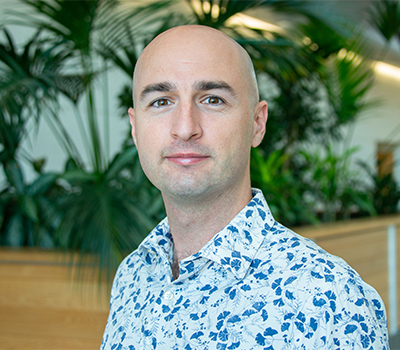Justin Conover, PhD, is a plant biologist whose fascination with the complexity of plant genomes has its roots in his childhood. Raised in Pattonsburg, Missouri, a rural farming community of about 300 people in the northwest region of the state, Justin grew up immersed in agriculture. His father managed a Farm & Home store in a nearby town, and Justin’s early experiences helping clean the store and playing with the baby chicks, ducks, and rabbits that arrived each spring sparked an early appreciation for farming.
His interest deepened in high school, where he was active in The National FFA Organization. There, through speaking competitions, he found a unique way to dive into his scientific curiosity and share what he was learning with others. His award-winning speech, “Saving the World One Plant at a Time,” explored the promise of genetic engineering in agriculture. That experience marked the beginning of a lifelong fascination with plant genomes. “I still have the notecards I used for practicing that speech,” Justin shared.
Nature’s Magic Trick
What drew Justin to plant genomics was the sense that these genomes held stories—stories that are complex, ancient, and still hold a lot of mysteries to be solved.
“Understanding how plant genomes have been shaped over millions of years by natural selection—and that every species has a unique story to tell—means there is always more to learn about the plants that we interact with on a day-to-day basis,” said Justin.
His research centers on polyploidy—the process by which a plant ends up with more than two sets of chromosomes. Polyploidy can happen within a single species or through hybridization between species, resulting in organisms that may look similar but have vastly different genetic architectures. In fact, some plants end up with four, six, or even twelve or more copies of every chromosome. His work aims to understand how these massive changes to the genome affect everything—from how the plant grows to how natural selection shapes its evolution.
“To me, polyploidy seems like nature’s magic trick—and I want to learn how the trick is done,” he explained.
His interest in polyploidy began in 2013, when he participated in a Research Experience for Undergraduates (REU) program at Iowa State University. “I haven’t turned my back on it since,” he said. Today, Justin’s lab uses a blend of comparative genomics, population genetics, and phylogenetics to investigate polyploidy at multiple timescales. His research explores both the immediate impacts of polyploidy on populations and species and ancient whole genome duplication events in flowering plant families.
One area of particular focus is the Malvaceae, or mallow family, which includes crops such as cotton, chocolate, hibiscus, and durian. Within this group, Justin has studied an extraordinary genome multiplication event—one where the genome was multiplied five or six times over. In the aftermath of this event, some individuals may have had up to twelve copies of every chromosome—an astonishing level of complexity that raises major questions about genome function, stability, and evolution.
Research in Action
Beyond curiosity, Justin’s work has important practical implications. Polyploidy is widespread in modern crops; wheat, cotton, soy, strawberries, and coffee are all polyploids. “You could cook an entire meal with only polyploids,” he notes, underscoring just how central these plants are to our daily lives. By understanding how these genomes operate and evolve, his research can inform future crop improvement efforts, especially as agriculture faces pressure from escalating environmental challenges.
Justin’s work also pushes the boundaries of evolutionary theory. Many population genetics frameworks assume that organisms have only two copies of each chromosome, like humans do. But plants break that mold. Understanding how natural selection operates in polyploid species can reveal new evolutionary patterns and improve the study of plants going forward. The Conover Lab seeks to bridge the gap between evolutionary theory and applied plant science.
For Justin, discovery is as much about the journey as the destination. “That brief moment when you realize that your analysis revealed an answer to a difficult problem that you had spent a lot of time trying to figure out—and then realizing that you are literally the only person in the world who has ever known that answer—there’s no feeling like that,” he said. “Being around supportive and caring people who share that same sense of wonder makes the process even better.”
Fun Fact
Outside the lab, Justin is a music enthusiast who played trumpet in the marching and concert bands in high school and college. He’s excited to dive into the St. Louis musical theater scene, especially at the historic Fox Theater and The Muny.





